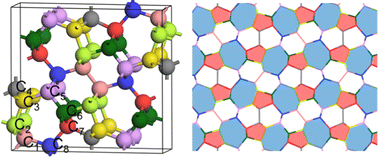Is Pbam-32 thermodynamically stable compared with diamond and graphite under variable pressure and temperature conditions?†
Abstract
Pbam-32 is a new carbon allotrope formed by hybrid sp3 atoms. It is promising for application as a super-hard material owing to its remarkable Young's modulus and Vicker's hardness. However, thermodynamic properties related to the stability, production and practical performance of Pbam-32 are still unclear, so further study is required to clarify these details. With the help of ab initio simulations, we systematically explore the structure, atomic environment, phonon dispersion, entropy and enthalpy changes of Pbam-32 compared with diamond and graphite. As an allotrope consisting of five-membered and seven-membered rings, Pbam-32 is a meta-stable structure without imaginary frequencies in phonon dispersion. An acoustic band gap between 39.58 THz and 42.57 THz indicates potential applications of Pbam-32 as a terahertz phononic crystal. The entropy and enthalpy of Pbam-32 are similar to those of diamond. Besides, Pbam-32 exhibits an excellent ability to resist pressure. Unfortunately, the free energy of Pbam-32 is higher than that of diamond over a wide range of pressure and temperature conditions, which means that Pbam-32 is absent in the phase diagram of the three allotropes. Therefore, the production of Pbam-32 must be kinetically controlled. Our results are helpful for understanding the thermodynamic properties of Pbam-32.



 Please wait while we load your content...
Please wait while we load your content...